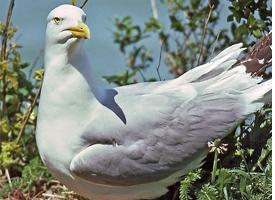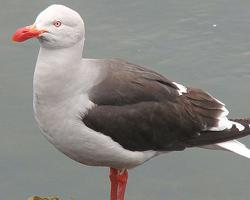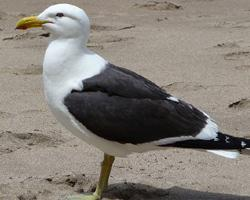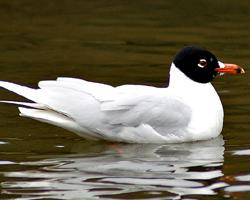
Stav ohrožení
| Ohrožen |
Popis zvířete
The American herring gull (Larus smithsonianus) is a large species of seabird that is part of the gull family. With a widespread presence across North America, this bird is a common sight along coastlines, inland lakes, and garbage dumps, showcasing its adaptable nature. The species was named in honor of Smithsonian Institution's founder, James Smithson, reflecting its significance in American natural history.Physical Characteristics:
The American herring gull is a robust bird, featuring a body length that ranges from 55 to 66 cm (22 to 26 inches), a wingspan of approximately 120 to 155 cm (47 to 61 inches), and a weight that can vary between 750 to 1250 grams (1.65 to 2.76 pounds). Adults display a striking plumage with a white head, chest, and underparts. The back and upper wings are a light grey, while the wingtips are black with white spots known as "mirrors" due to their reflective appearance. One of the most distinguishing features of the adult American herring gull is its bright yellow eye, surrounded by a thin red orbital ring, which contrasts sharply with its yellow bill marked by a distinctive red spot on the lower mandible. Legs and feet are usually pinkish in color.
Juveniles and subadults go through a series of moults before acquiring the full adult plumage. Initially, they are mottled brown and gradually lighten over four years, acquiring more of the grey and white adult coloration with each successive moult. This prolonged maturation process makes it challenging to identify young birds' ages without close observation.
Behavior:
American herring gulls are versatile feeders, showcasing a diet that includes fish, insects, small birds, eggs, rodents, and an assortment of garbage and carrion. They are opportunistic and have been observed using ingenious methods to access food, such as dropping shellfish onto rocks from a height to break them open. Their feeding habits underscore their adaptability to various environments, from natural settings to urban landscapes.
These gulls are colonial nesters, preferring to breed in large, densely packed colonies on islands, coasts, or inland near bodies of water. Their nests are constructed on the ground and are made from grass, twigs, and feathers. A typical clutch consists of two to four eggs, which both parents incubate. The chicks are precocial, born with their eyes open and covered in down, ready to leave the nest shortly after hatching, although they remain dependent on their parents for food and protection for an extended period.
Communication among American herring gulls is complex, involving a variety of calls, body postures, and behaviors that convey different messages, from warnings of predators to courtship.
Conservation Status:
Currently, the American herring gull is classified as Least Concern by the International Union for Conservation of Nature (IUCN), reflecting its wide distribution and large population. However, like many species, it faces threats from pollution, habitat loss, and human disturbance. Efforts to monitor populations and protect critical habitats are essential for ensuring the species' long-term survival.
In conclusion, the American herring gull is a fascinating bird, emblematic of coastal regions and human-altered landscapes across North America. Its adaptability and complex behaviors make it a subject of interest not only for ornithologists but also for nature enthusiasts who marvel at the resilience and intelligence of these ubiquitous seabirds.
Podobná zvířata
Nové fotografie zvířat
Top 10 zvířat
- Common house mosquito (Culex pipiens)
- Common cockchafer (Melolontha melolontha)
- Colossal squid (Mesonychoteuthis hamiltoni)
- Hooded merganser (Lophodytes cucullatus)
- Australian box jelly (Chironex fleckeri)
- Fruit fly (Drosophila melanogaster)
- Common reed warbler (Acrocephalus scirpaceus)
- Elephant hawk moth (Deilephila elpenor)
- Moustached guenon (Cercopithecus cephus)
- Diana monkey (Cercopithecus diana)


